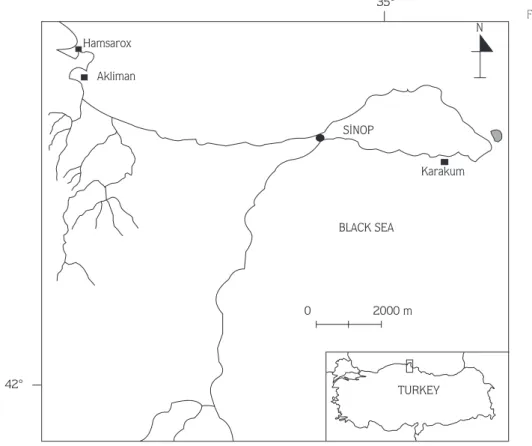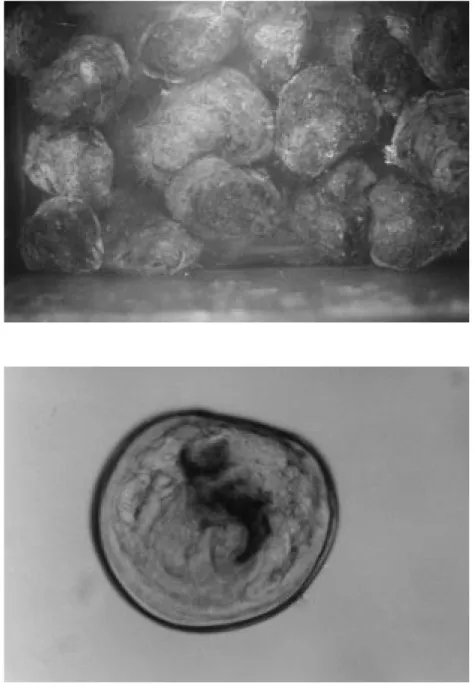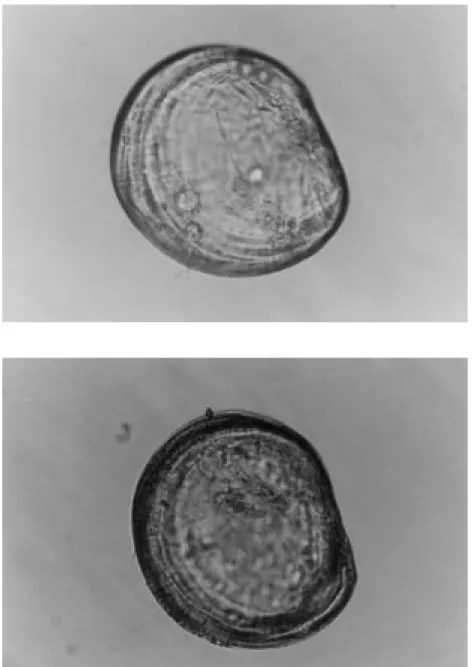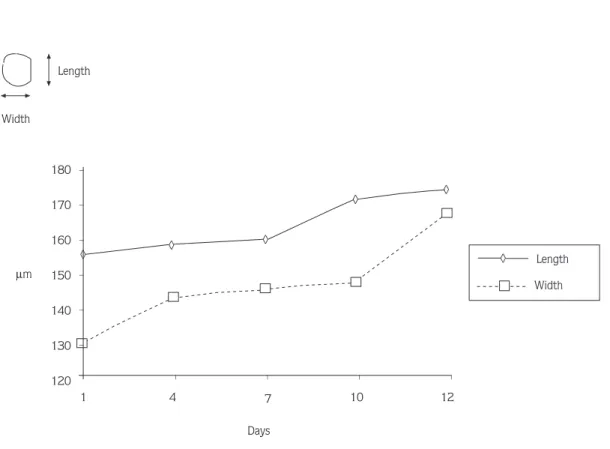A Study on the Possibilities of Obtaining Larva From Native Flat Oysters
(Ostrea edulis L.) Living in the Black Sea and Larval Metamorphosis Stage
Orhan UYAN, Orhan ARAL
University of Ondokuz MayÝs, Sinop Fisheries Faculty, Department of Aquaculture, 57000, Sinop-TURKEY
Received: 09.06.1999
Abstract: In this research, the possiblities of obtaining larva from oysters (Ostrea edulis L.) living in the Black Sea and their
metamorphosis stage were investigated. There were no difficulties in obtaining larvae. The results of this investigation indicate that flat oyster (Ostrea edulis L.) culture is possible in Black Sea conditions.
Key Words: Oyster, Ostrea edulis L, culture, larval development, Black Sea.
KaradenizÕde Bulunan Üstiridyelerden (Ostrea edulis L.) Yavru Elde Etme OlanaklarÝ ve Larval Metamorfoz SŸreci †zerine Bir AraßtÝrma
…zet: Bu •alÝßmada, KaradenizÕde bulunan istiridyelerden (Ostrea edulis L.) yavru alma olanaklarÝ ve elde edilen larvalarÝn metamorfoz
sŸrecinin saptanmasÝ ama•lanmÝßtÝr. Üstiridye larvalarÝnÝn elde edilmesinde bir gŸ•lŸk yaßanmamÝßtÝr. Sonu• olarak, Karadeniz koßullarÝnda istiridye (Ostrea edulis L.) yetißtiriciliÛinin mŸmkŸn olduÛu belirlenmißtir.
Anahtar SšzcŸkler: Üstiridye, Ostrea edulis L., Yetißtiricilik, Larval gelißim, Karadeniz.
Introduction
The oyster is one of the most commonly cultured demersal marine organisms in the world. It is found in almost all sea areas except the Arctic and Antarctic regions. The flat oyster, Ostrea edulis L., is the only oyster species which is found on the coasts of Turkey (1-7).
Today, the annual worldwide oyster harvest, which consists of catching and culturing, is around one million tons, including approximately 200 oyster species. The figure is around 1500 tons, all of which has been obtained by catching and there are no activities regarding oyster culture in Turkey (3, 8, 9).
Ostrea edulis L., whose lower (left) valve is convex and upper (right) valve is flat, lives on firm ground in shallow coastal waters down to a depth of 20 m. The oyster, which is a prominent mollusc in the interdial zone, like other bivalves, can reach other sea areas in its larval stage. The length of the oyster is around 10-12 cm. Ostrea edulis, which is widely distributed in northwestern Europe, can be found in estuaries, and tolerates salinities of up to 23ä. It often occurs in large beds on muddy-sand, muddy-gravel and rocks. Mainly, their prey is made up of phytoplankton such as Isochrysis galbana, Dunaliella tertiolecta and Tetraselmis suecica (2, 10-15).
The reproduction biology of Ostrea edulis is very interesting. Ostrea edulis, which is a hermaphrodite organism, changes sex, according to the temperature and feeding conditions. After 8-10 months of growth and water temperatures of at least 16¼C, Ostrea edulis matures, becoming male and releasing sperm. Then it becomes female and begins egg production. The sex variation of Ostrea edulis, which cannot be fertilized by itself, continues throughout its life span. Eggs, which themselves are attached to the mantle cavity of the female, are fertilized by sperm released by the male brought in with the feeding current of the female. They subsequently develop into fully shelled larvae before being discharged into the sea, where they undergo the rest of their development. The most noticeable structure of the larva is the velum or swimming organ, a circular lobe of tissue bearing a ring of cilia by means of which the larva both swims and feeds. Also noteworthy are an extensible ciliated foot and black eyespot (Fig. 1) (12, 14).
Phytoplankton, which forms the food of the larva, is caught by cilia, thrown against the base of velum and carried to the mouth. The larva alternates between periods of swimming fairly rapidly upwards and slowly sinking through the water column. If it is disturbed, the
velum can be completely retracted and the two valves of the shell are closed. The closed larva is so efficiently protected that it can be briefly rinsed with toxic chemicals, such as a dilute solution of chlorin, without being harmed (14).
The length of larvae is usually 170-190 µm at liberation, and this increases to 290-300µm, and exceptionally to 360 µm, at the end of larval development. The most critical stage in the larval development of Ostrea edulis is metamorphosis, which is
a transition from pelagic to benthic state. The duration of the free-swimming period is about 10 days; variations in this figure will occur due to differences in temperature and food supply. As the larva approaches metamorphosis, the structure becomes more complex and the shell shape is characterized according to the species. Metamorphosis is a critical stage in the life span, since the ability to move is lost, and the interdial organs change to suit a sedentary existence. When a satisfactory position is found, the larva settles on its left valve and lives in the same position the rest of its life (2, 5, 10, 12-14).
aa dg i st es h pa g em a s f m v
Figure 1. Prominent anatomical features of an oyster larva; aa: anterior adductor muscle, dg: digestive gland, i: intestine, st: stomach, es: eyespot, h: heart, pa: posterior adductor muscle, g: gill, em: edge of the mantle, a: anus, s: shell, f: foot, m: mouth, v: velum (Photographs: original (x200): Fig.: to (15)).
The morphogenic events related to mechanism of feeding during transition from metamorphosing planktonic larva to benthic adult are complex, but are an important subject of discussion in energy storage (they are responsible for the larvaÕs inability to feed during metamorphosis). The induction of metamorphosis in the larva is followed by the rapid disintegration of the velum, which limits locomotion and feeding. Two or three primordial gill lamellae may be present, which aid respiration but appear not to be functional with respect to retention of food particles. Upon settlement, the velum is completely resorbed, and the poorly defined feeding currents of the gill become organised over a period of 2-8 days. During this transition, energy requirements are met by using lipid reserves stored prior to metamorphosis. It has also been reported that the larval survival rate is correlated with the feeding conditions of the broodstock before spawning season. Metamorphosis is complete at the end of this stage, and Ostrea edulis goes on living in this form (14, 16-18).
The objectives of this study were to determine the possibilities of obtaining larvae and to investigate the larval metamorphosis stage.
Materials and Methods
A total of 20 broodstock flat oysters were collected from natural populations in Sinop Bay, Karakum locality, on the north coast of Turkey during the months of June, July and September 1996 (Fig. 2). The collection depth was 15 m. They were maintained in special oyster bags which were lowered to a depth of 5 m from the surface at the time of the trial, May 1997. At the beginning of the trial, they were placed in an aquarium of 80x40x40 cm and were supplied with unfiltered seawater of 18ä salinity (Fig. 3). They were conditioned to spawn at a constant water temperature of 21¼C. Broodstocks were left to spawn larvae naturally. At release, larvae were collected and placed in an other aquarium under the same conditions. Throughout the trial, metamorphosing larvae were observed in the larval aquarium. The seawater of the aquariums was replaced with fresh seawater twice a week so that broodstocks and larvae could feed on the phytoplankton in the fresh seawater. The lengths and widths of larvae were measured (according to the longest distance along the anterior-posterior line of the shell (length) and to the distance from the tip of the umbo to the ventral margin of the shell (width), respectively) under a microscope and photographed (x200, Nikon Lobophop-2A AFX-BX microphotograph apparatus) (19).
N BLACK SEA 2000 m 0 TURKEY Karakum SÜNOP 35¡ Hamsarox Akliman 42¡
Figure 2. The collecting area of the broodstock oysters.
Results
The moment of liberation of an oyster larva was observed and is shown in Figure 4.
When the larva had been liberated, it could move using the velum. Although the larva shown in Figure 4 has just been liberated, the velum is not visible because when the larva was disturbed, the velum was completely retracted and the two valves of the shell were closed.
An oyster larva able to move in water with its velum and prominent anatomical features is shown in Figures 1
and 5. The internal organs of the larva are visible since the shell is transparent, as shown in Figure 5.
An oyster larva at the beginning of the metamorphosis stage which has entered benthic state, losing its movement ability, and which cannot feed because its velum is absorbed, is shown in Figure 6.
An oyster larva which has absorbed its velum and had partially completed metamorphosis is shown in Figure 7.
An oyster larva which has completed metamorphosis is shown in Figure 8.
Figure 3. Broodstock oysters.
Figure 4. An oyster larva which has just been liberated (original, x200).
Variation in the length and width of the larvae during their development are shown in Figure 9.
Discussion
In the present study, the possibilities of obtaining larva from native flat oysters (Ostrea edulis L.) living in the Black Sea were investigated, and the larval metamorphosis stage was studied.
As there were no difficulties in obtaining larvae, no breeding methods were used.
The larvae had a lower growth rate than that reported in the literature (14, 16, 18) because of inadequate feeding conditions. It is thus clear that larvae must be fed appropriately with phytoplankton qualitively and quantively so as to allow an optimum larval growth rate.
When the larvae were liberated, their mean length and width were 155.2 x 129.9 µm, whereas after 12 days, they were 174.6 x 167.3 µm. During this stage, proportional length and width gains were 12.5 % and 28.8 %, respectively. According to Figure 9, it was Figure 5. An oyster larva which moves by using its velum (original, x200).
Figure 6. An oyster larva which has settled at the bottom (original, x200).
observed that the larvae were unable to feed during metamorphosis because of the disintegration of the velum, which enables larvae to move and feed (day 4-7). In this stage, the energy requirements of the larvae were met by lipid reserves stored prior to metamorphosis. When the metamorphosis stage was complete (day 10), the larval growth rate increased (16-18).
Only 20 adult oysters were collected in 15 diving operations because the natural oyster population of the Black Sea is low. In addition, there are dangers which
threaten oyster stocks in the Black Sea. The most serious threat to the oyster stocks in the Black Sea is the oyster drill snail, Rapana venosa. As a mass bottom-living carnivore, the snail preys on oysters, mussels and other bivalves and can cause extensive damage to oyster beds, feeding on the sedentary oysters (20). Furthermore, it has also been reported that the local hydrography with low salinity, temperature and unknown events results in low and variable recruitment of juvenile oysters on natural oyster beds, although adult Ostrea edulis survives and grows well (21).
Figure 7. An oyster larva which has absorbed its velum (original, x200).
Figure 8. An oyster larva which has c o m p l e t e d m e t a m o r p h o s i s (original, x200).
According to the results of this study, flat oyster (Ostrea edulis L.) culture is possible in Black Sea conditions. The necessity of supporting and developing
oyster culture is based on the fact that oyster culture has commercial importance and that it supports limited natural stocks in the Black Sea region.
References
1. Milne, P. H., Fish and Shellfish Farming in Coastal Waters. Fishing News Books Ltd. Farnham, Surrey, England, 210p., 1979. 2. Sabelli, B., The Macdonald Encyclopedia of Shells. Macdonald
Ilustrated Book, 512p., 1991.
3. Anonymous, FAO Fisheries Statistics, Vol : 75., 1992.
4. Mutlu, E., †nsal, M., Relative Numeric Importance of Different Soft-Bottom Benthic Groups (Molluscs and Crustaceans) in The Southern Black Sea. Cercerati Marine, I. R. C. M., Nr: 14-25, 133-143, 1991-1992.
5. Campbell, A., Seashores and Shallow Seas of Britain and Europe. The Hamlyn Publishing Group Ltd., 320 p., 1994.
6. Anonymous, Black Sea Transboundary Diagnastic Analysis. GEF, BSEP, United Nations Publications Sales No: E.97.III.B.15, 142p., 1997.
7. Zaitsev, Y., Mamaev, V., Biological Diversity in The Black Sea. GEF, BSEP, Black Sea Environmental Series, Vol. 3, United Nations Publications Sales No: 95.III.B.6,208p., 1997.
8. Anonymous, Fishery Journal, No. 28. Published by Yamaha Motor Co. Japan, 1989.
9. Anonymous, Su ŸrŸnleri Üstatistikleri, T. C. BaßbakanlÝk Devlet Üstatistikleri EnstitŸsŸ, Yay. No: 2075, 1996.
10. Fish, J. D., Fish, S., A Student Guide to the Seashore. Academic Division of Unwin Hyman Ltd., London, 473p., 1989.
11. Barnes, R. S. K., The Brakish-Water Fauna of Northwestern Europe. Cambridge University Press, 312p., 1994.
12. Muus, B. J., Collins Guide to the Sea Fishes of Britain and North-Western Europe. Collins Publications, 244p, 1995.
13. Karleskint, G., Introduction to Marine Biology. Saunders College Publishing., 528p., 1998.
14. Walne, P. R., Culture of Bivalve Molluscs. Fishing News Books Ltd., 191p., 1979.
15. Pechenik, J. A., Biology of the Invertebrates. Wm. C. Brown Publishers, 545p., 1995. 12 10 7 4 1 Days µm 180 170 160 150 140 130 120 Width Length _ _ _ _ _ _ _ _ _ _ ◊ ◊ ◊ ◊ ◊ ◊ ◊ ◊ ◊ Length Width
16. Gallenger, S. M., Mann, R., Sasaki, G. C., Lipid as an Index of Growth and Viability in Three Species of Bivalve Larvae. Aquaculture, 56: 81-103, 1986.
17. Holland, D. L., Lipid Reserves and Energy Metabolism in the Larvae of Benthic Marine Invertebrates, 1978. From: Gallenger, S. M., Mann, R., Sasaki, G. C., Lipid as an Index of Growth and Viability in Three Species of Bivalve Larvae. Aquaculture, 56: 81-103, 1986.
18. Gallenger S. M., Mann, R., Growth and Survial of Larvae of Mercenaria mercenaria (L.) and Crassostrea virginica (Gmelin) Relative to Brookstock Conditioning and Lipid Content of Eggs. Aquaculture, 56: 105-121, 1986.
19. Loosanoff, V. L., Davis, H. C., Chanley, P. E., Dimensions and Shapes of Larvae of Some Marine Bivalve Mollusks, Malacologia, 4(2): 351-453, 1966.
20. …ztŸrk, B., …ztŸrk, A.. A., On the Biology of the Turkish Straits System. Bulletin de IÕInstitute Oceanographique, Monaca, No. Special 17, CIESM Science Series, N.2: 205-221, 1996. 21. Berntsson, K. M., Jonsson, P. R., Wangberg, S. A., Carlsson, A.
S., Effects of Broodstock Diets on Fatty Acid Composition, Survival and Growth Rates in Larvae of the European Flat Oyster, Ostrea edulis. Aquaculture, 154: 139-153, 1997.





